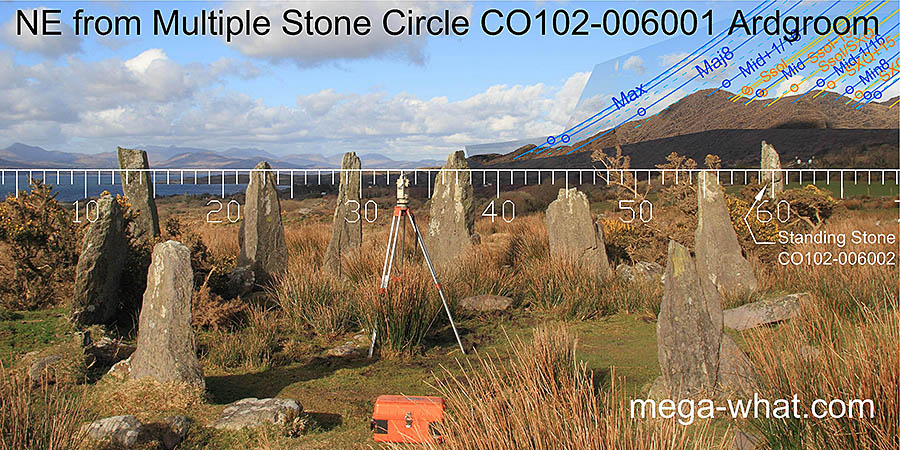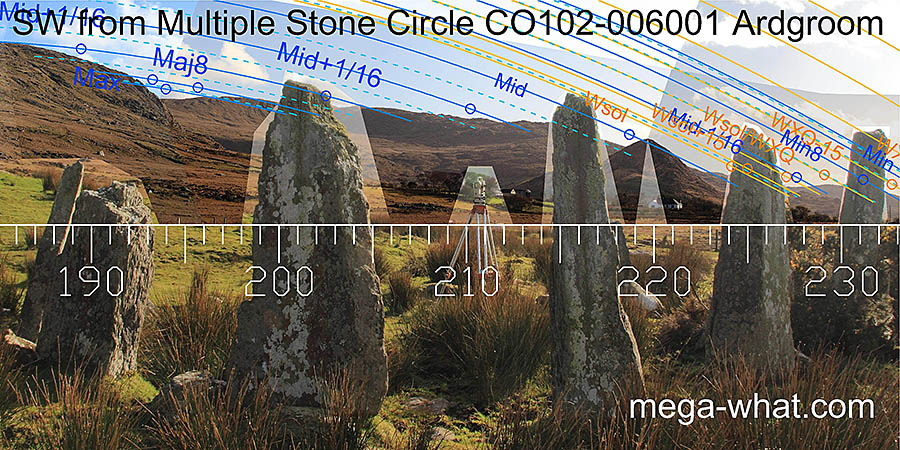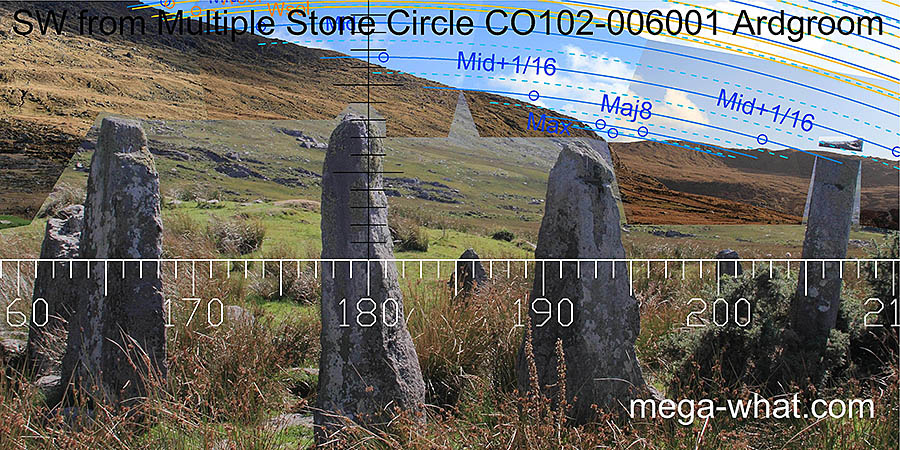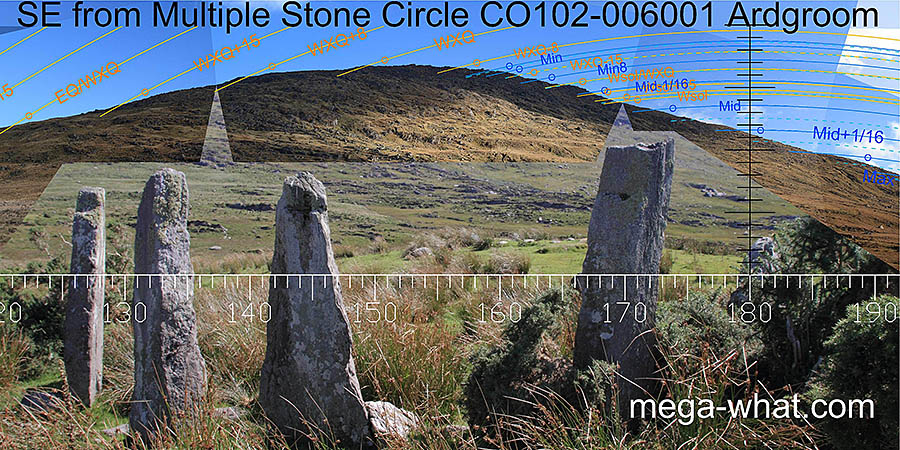Axial alignments of 45 surveyed Stone Circles.
Sorted by: Location Name | Alignment Class
These are all Cork-Kerry type Axial Stone Circles, both the five-stone and the multiple-stone types.
- For classification purposes these surveyed horizons have been divided into a small number of zones. This classification is an overall one that considers all axes to be potentially bi-directional.
- Extreme is where sun and moon never rise or set but excludes the north-south axis of celestial rotation.
- Lunar is where lunistices
Lunistices are the most northerly and southerly moons of the month. The lunar equivalent of solstices. More.
occur but sun rises or sets do not.
- Solar is where sun rises or sets occur but lunistices do not.
- Solar / Lunar is where a lunistice zone overlaps with the outer regions of the sun's annual travels.
Alternatively one direction may be purely solar while the other is somewhere within a lunistice range.
- Note that these terms may well have other uses elsewhere.
Axial Alignment Classes of surveyed stone circles
| Type | Number | Solar | Solar / Lunar | Lunar | Extreme | North-South
|
|---|
| Multiple Stone Circles | 22 | 7=32% | 5=23% | 7=32% | 3=14% | -
|
| Five Stone Circles | 23 | 7=30% | 9=39% | 6=26% | 1=4% | -
|
| All Stone Circles | 45 | 14=31% | 14=31% | 13=29% | 4=9% | -
|
- This sample is c.40% of known Cork-Kerry type stone circles.
- The Multiple Stone Circles, which are earlier, have considerably fewer solar/lunar axial alignments than the Five Stone type but three times as many extreme axes.
Of this sample (excluding the four with extreme axes): nine are uni-directional and thirty-two are bi-directional.
Of these, six multi-stone circles are uni-directional and thirteen are bi-directional while three five stone circles are uni-directional and nineteen are bi-directional.
See for yourself:
- Orange Solar trajectories split the tropical year into 48 "Tweeks" (7.6 day mean) that are better regarded as quarter-months.
- Solid Blue Lunar lines split cyclical lunistice position variation into 16 periods of about 14 months each.
- Lunistices are the most northerly and southerly moons of the month [More].
- Also see Technical Notes on the Pictures
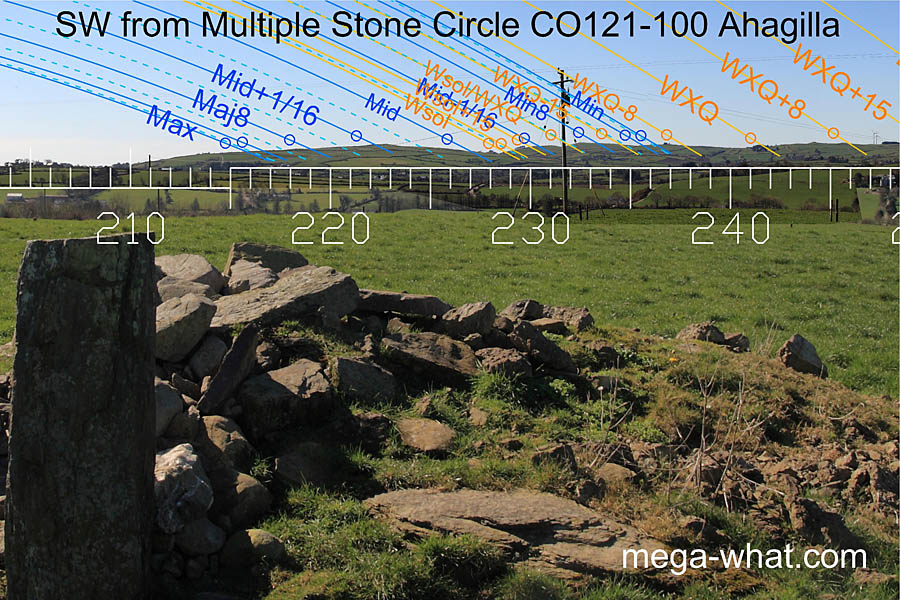
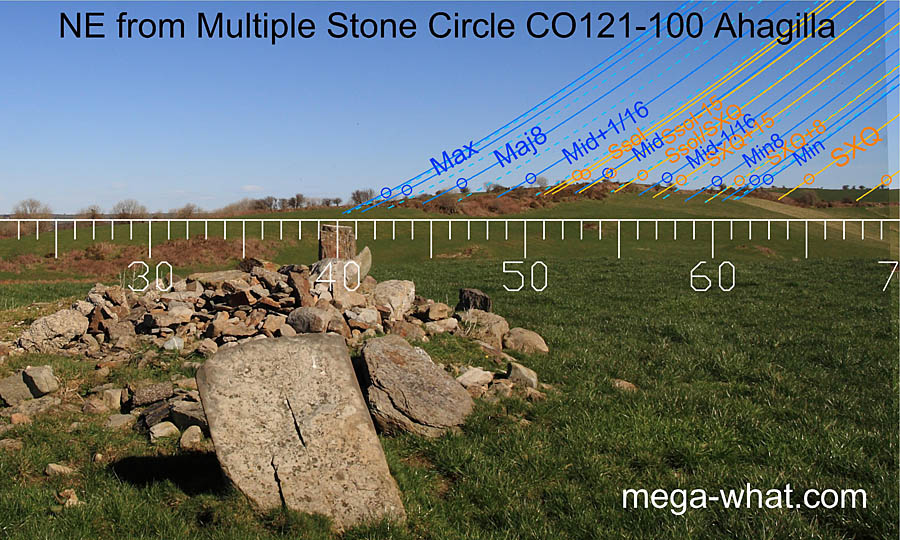 Ahagilla Stone Circle
Ahagilla Stone Circle:
Only two stones are in situ and undamaged, the axial and south portal.
The circle axis indicates the major end of the lunistice range to the south-west but north-eastwards is slightly beyond major standstill.
This indicates that the critical axial orientation is towards the south-west.

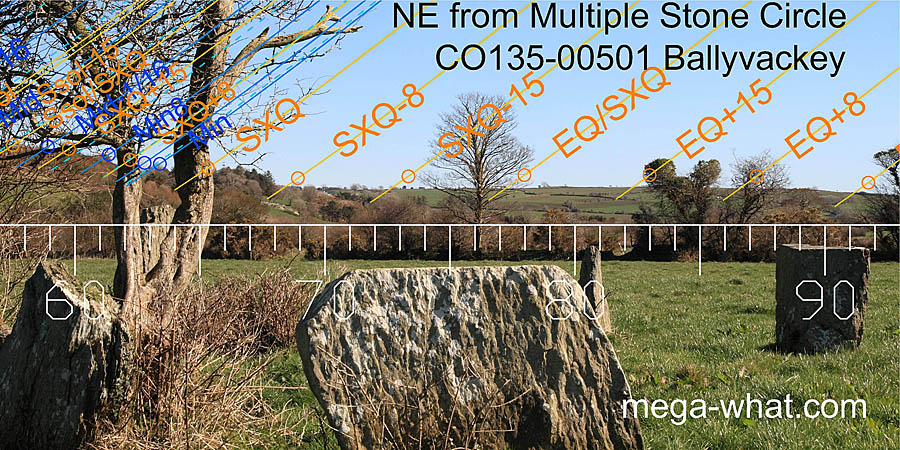 Ballyvackey Stone Circle
Ballyvackey Stone Circle:
The north portal is missing but the axis seems to span the period of two to one weeks before spring equinox (after the autumn one).
The north-eastern axis is in the vicinity of equinox / summer cross-quarter midpoint.
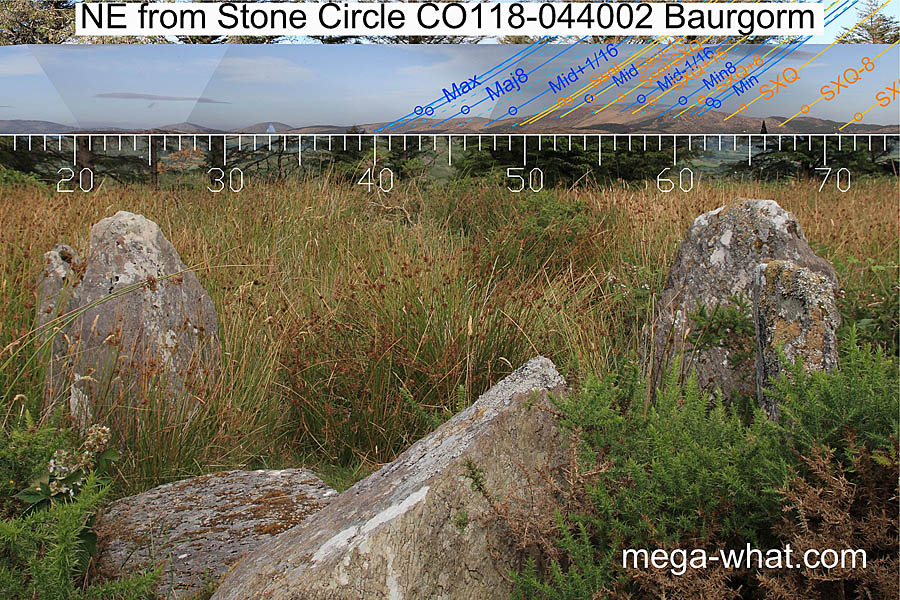
 Baurgorm (E) Five Stone Circle
Baurgorm (E) Five Stone Circle:
The axial stone is unusual in having a very sloping top, the gap between the portals is uncommonly wide and the south-western horizon is very close.
Given all that, the north-east axis is towards the major end of the lunistice range while the south-west one is towards the minor end.

 Baurgorm (W) Stone Circle
Baurgorm (W) Stone Circle:
The north portal is fallen but the axial stone clearly spans the major half of the lunsitice range. North-eastwards, the reverse would just contain the major standstill.

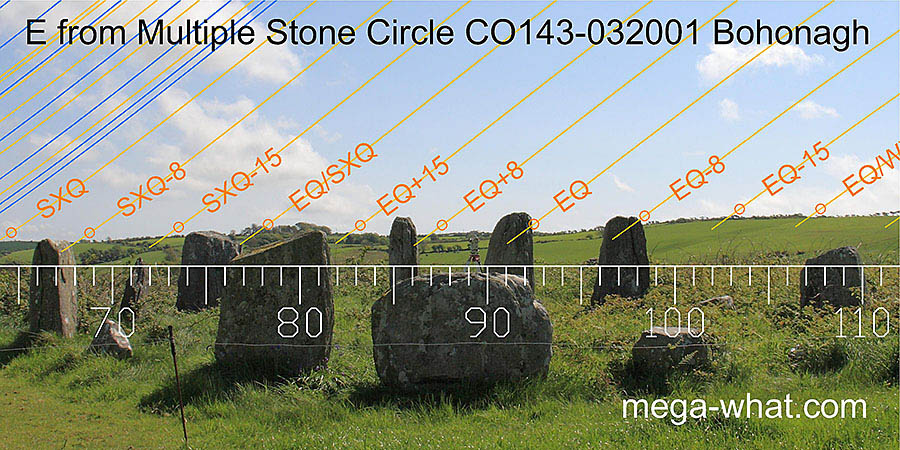 Bohonagh Stone Circle
Bohonagh Stone Circle:
The axis indicates equinox sunset. The reverse is a week or so before autumn equinox (after the spring one).

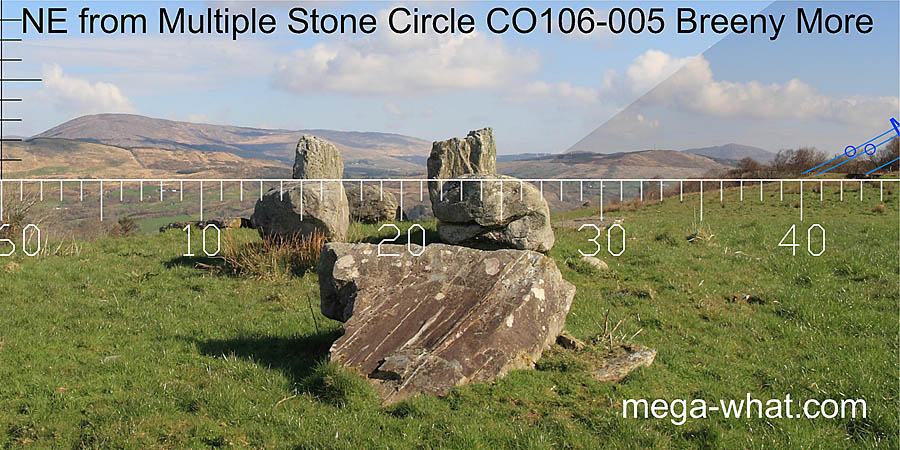 Breeny More Stone Circle & Boulder-Burials
Breeny More Stone Circle & Boulder-Burials:
The north-east / south-west axes of the circle and the rectangular arrangement of four boulder-burials are both extreme ones.
The circle roughly bisects the space between north / south and the major standstills. The boulder-burials are slightly less extreme.
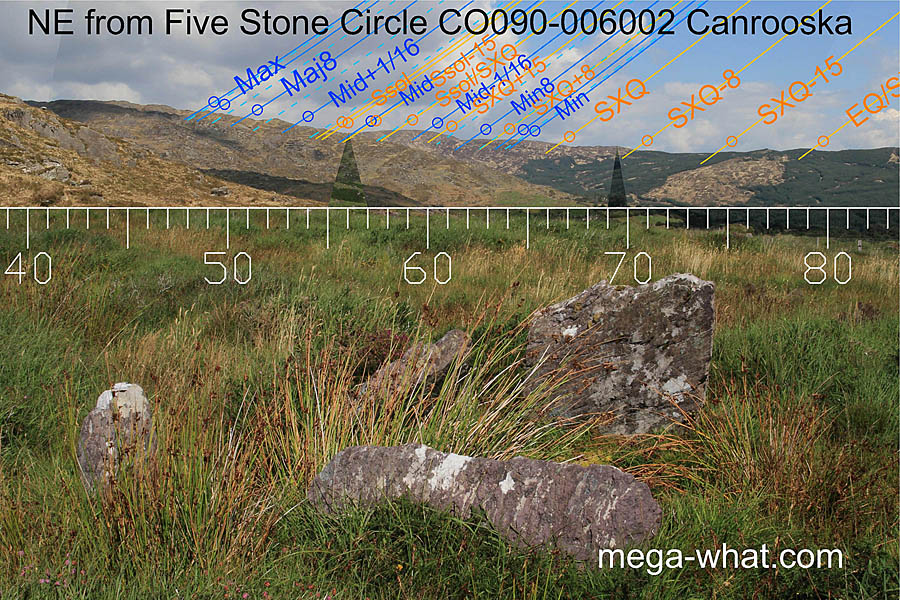
 Canrooska Stone Circle
Canrooska Stone Circle:
Built beside a stone row, sharing its position. The north portal is leaning badly & the axial stone is not perpendicular to the axis.
Seems to span a period of about a half-month north of winter cross-quarters; before Samhain, after Imbolc. The reverse is towards the minor half of the lunistice range.

 Cappaboy Five Stone Circle
Cappaboy Five Stone Circle:
The axis seems to indicate the major end of the lunistice range to the south-west while to the north-east it is beyond the major standstill.
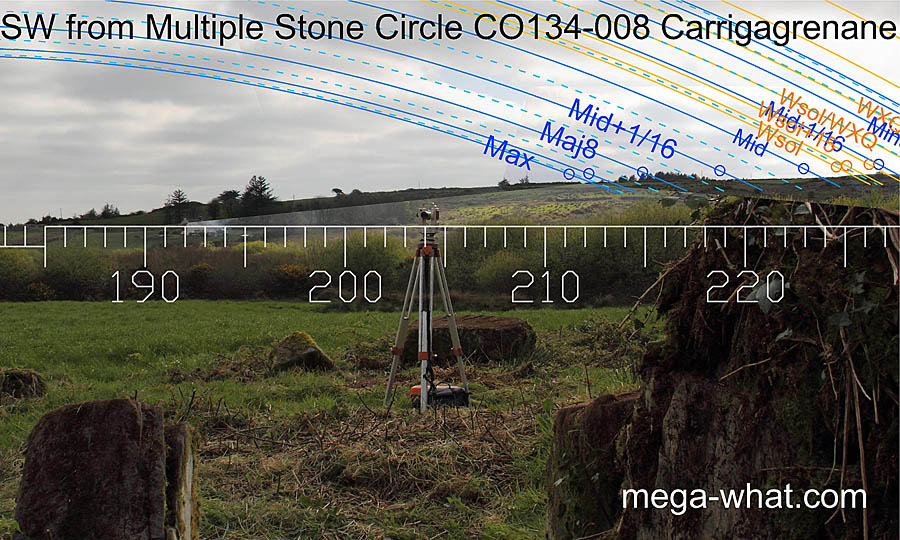
 Carrigagrenane Multiple Stone Circle
Carrigagrenane Multiple Stone Circle:
This is a complex circle with a fallen central monolith and radially set portals with an extra pair of stones outside them.
The axis is just beyond major standstill to the south-west, well beyond it to the north-east. Moving one space clockwise from the portal gap changes things radically
[Pic].
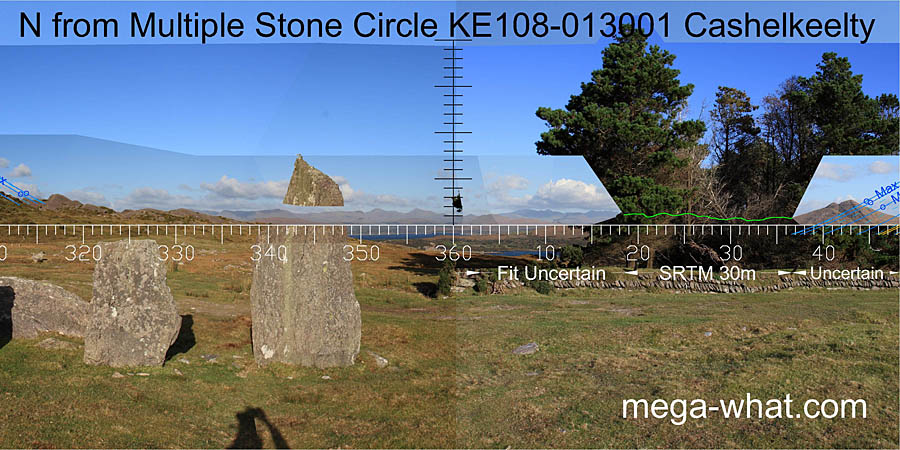
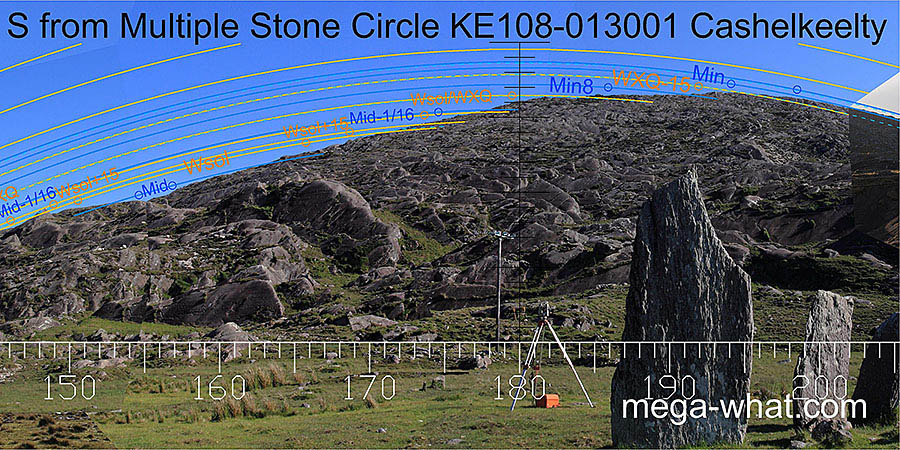 Cashelkeelty Multiple Stone Circle
Cashelkeelty Multiple Stone Circle:
Only three stones survive. Nevertheless, it seems likely that the tallest stone was a portal, thus indicating a north-south axis. Look south to see why. Excavated.
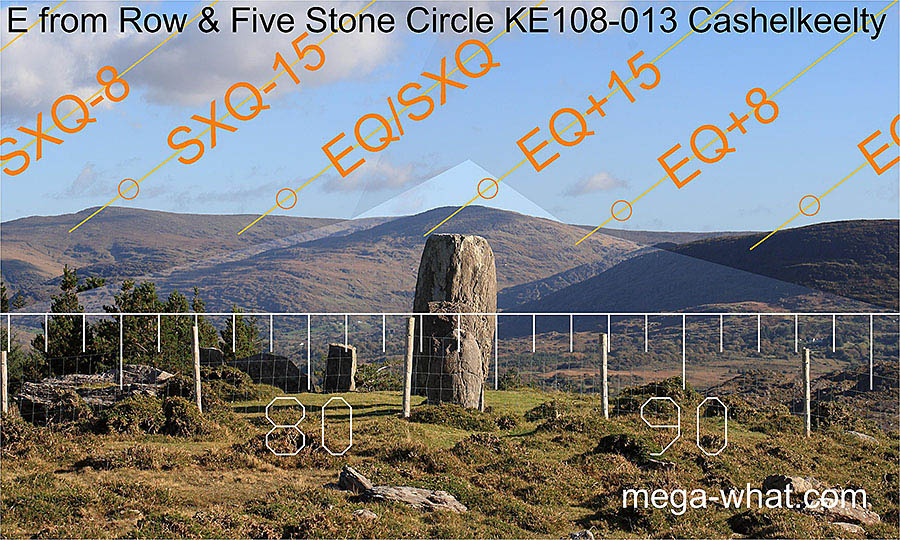
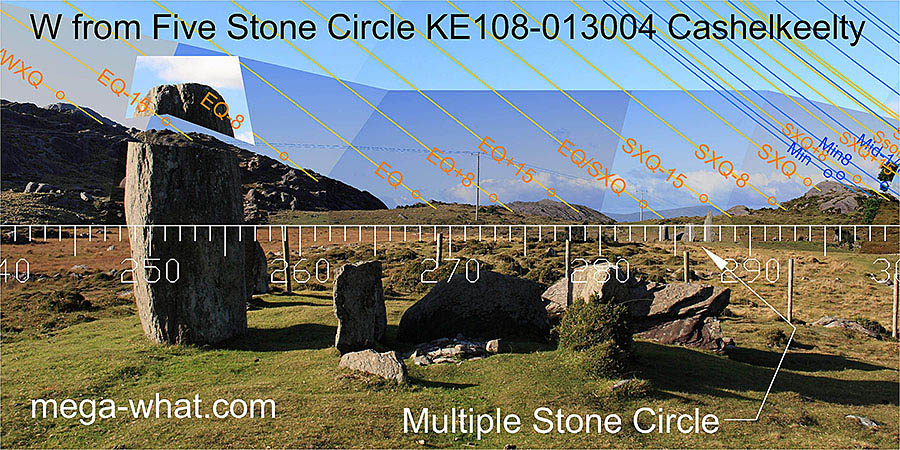 Cashelkeelty Five Stone Circle
Cashelkeelty Five Stone Circle:
Built beside a stone row. The row axis is a half-month or so from the equinox in both directions.
The circle axis is harder to determine due to the broken portals but seems to be more equinoctial. Excavated.
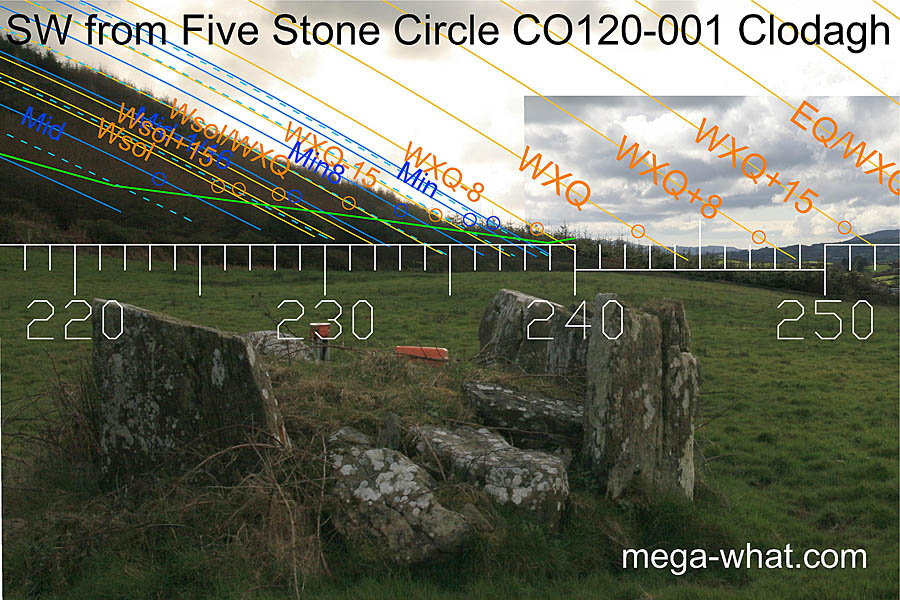
 Clodagh Stone Circle & Pair
Clodagh Stone Circle & Pair:
The circle axis perhaps indicates the solstice / equinox midpoint to the south-west but certainly summer solstice to the north-east.
The pair axis of c.217° indicates the limits of a month centred on winter solstice to the south-west but is slightly beyond major standstill to the north-east.
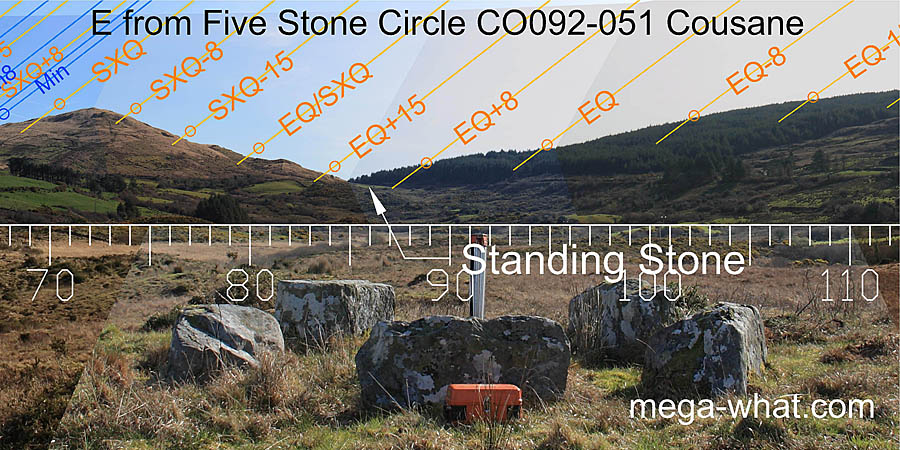
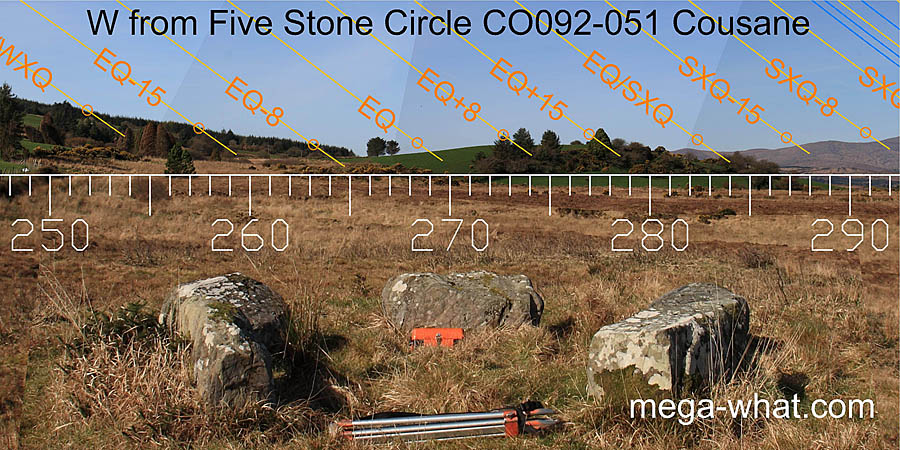 Cousane Five Stone Circle
Cousane Five Stone Circle:
The axis is more or less due east / west and spans about a week to the north of the equinox. Before Autumn equinox.

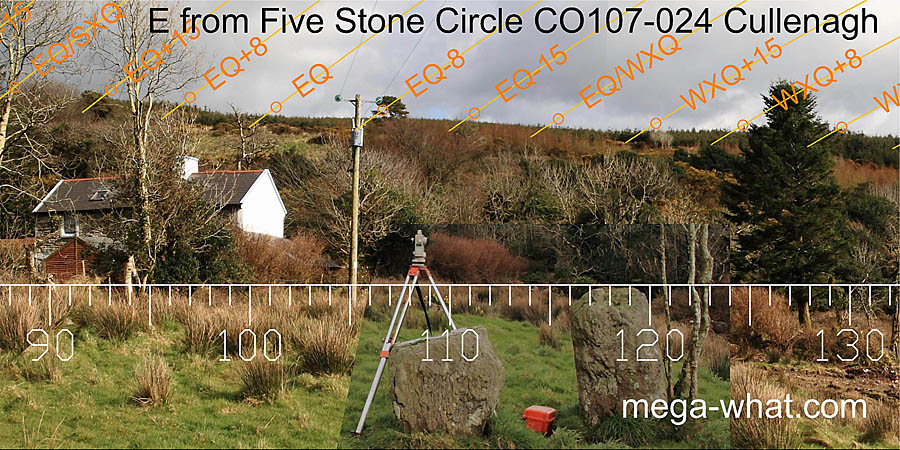 Cullenagh Stone Circle
Cullenagh Stone Circle:
Only the axial and south sidestone survive. The axis indicates summer cross-quarters. The reverse covers the half-month before spring equinox (after the autumn one).

 Cullomane Anomalous Stone Group
Cullomane Anomalous Stone Group:
This was probably a five-stone circle. If so then the upright stone would have been the north portal.
Given that, the north-eastern axial reverse indicated summer solstice sunrises while the south-western axis was half-way between winter solstice and winter cross-quarters.
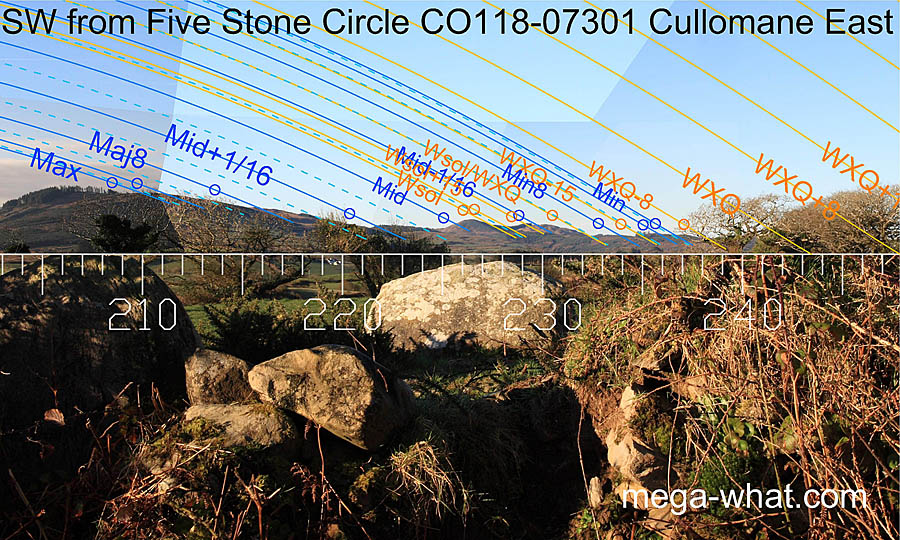
 Cullomane Five Stone Circle
Cullomane Five Stone Circle:
The circle axis indicates winter solstice sunsets while the reverse marks major standtill. The outlying standing stone (now fallen) occupies a critical position but may have been there first.
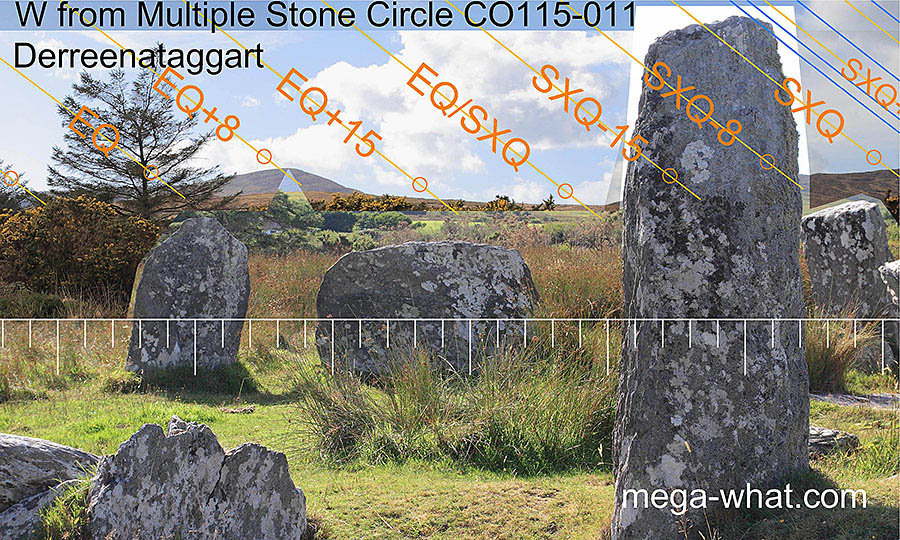
 Derreenataggart Stone Circle
Derreenataggart Stone Circle:
The south portal is a broken stump but in place. The western axis is centred a half-month north of the equinox (before the autumn one).
To the east, axial reverse contains the equinox and the week south of it (before spring equinox).
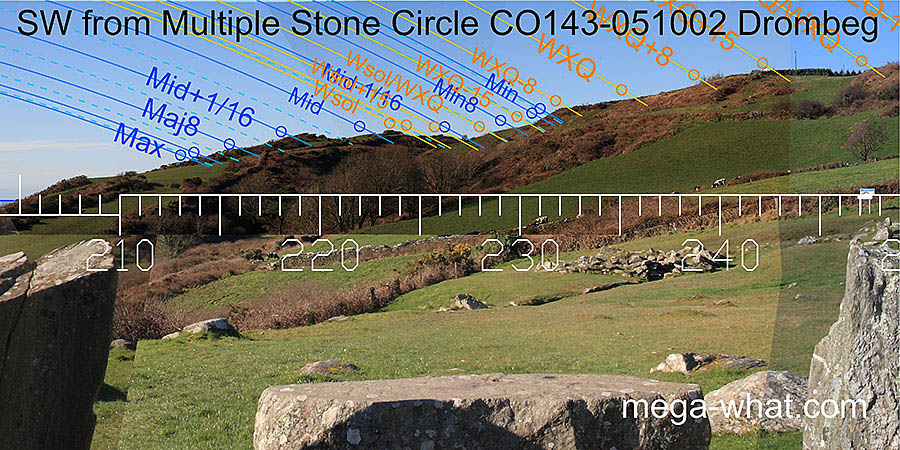
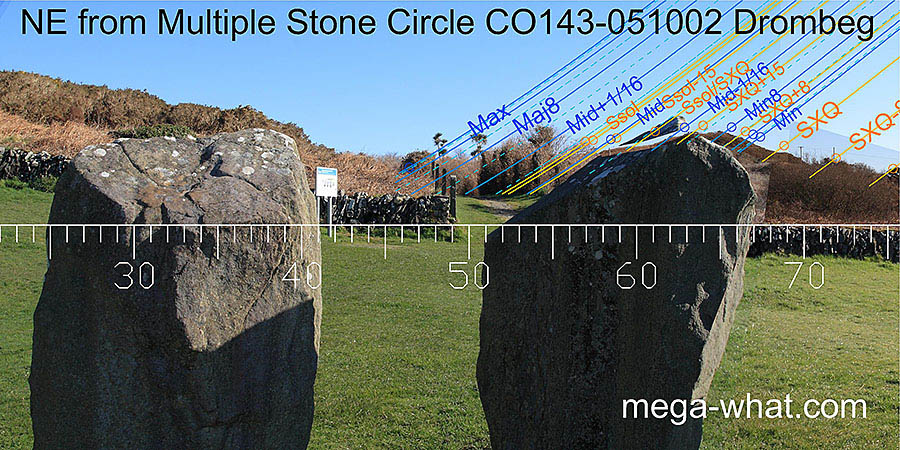 Drombeg Stone Circle
Drombeg Stone Circle:
The south-western axial notch marks the limits of a month centred on the solstice, not the solstice itself. The reverse axis indicates major standstill to the north-east.
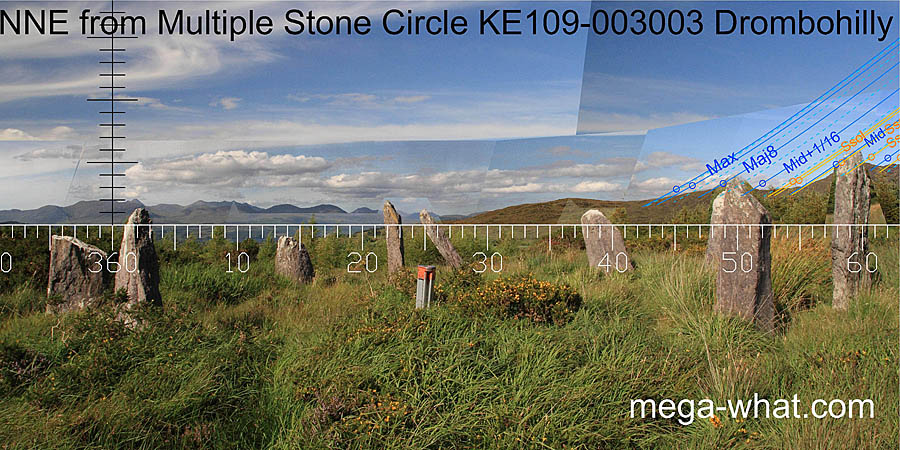
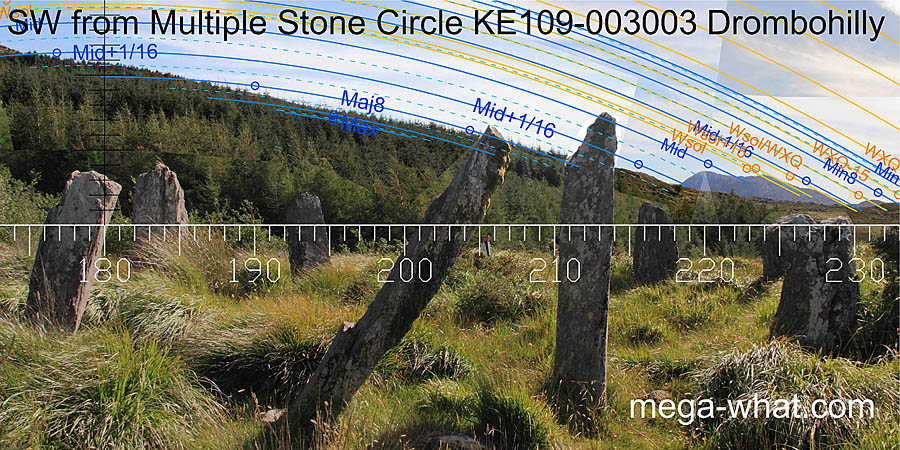 Drombohilly Stone Circle
Drombohilly Stone Circle:
Both radially set portals are in place though one is leaning. The tripod replaces the missing axial stone. Axial reverse roughly bisects the space between north and north-east major standstill.
The major end of the south-western lunistice range is axially indicated but now obscured. There would have been high precision.
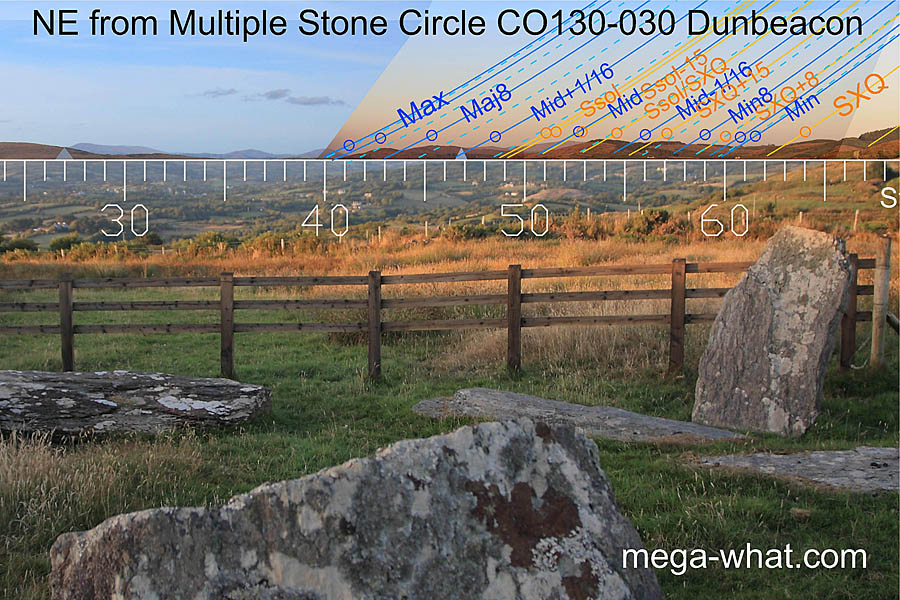
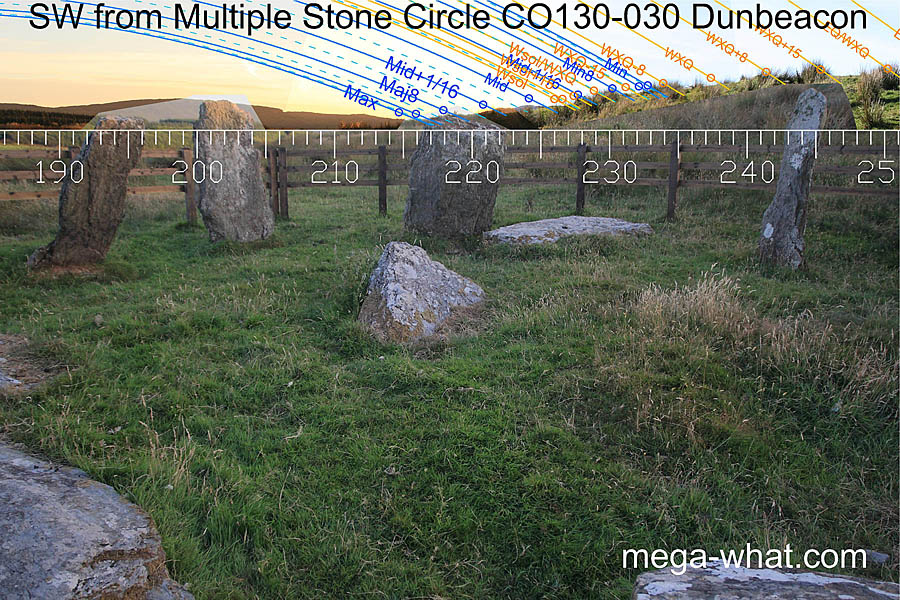 Dunbeacon Stone Circle
Dunbeacon Stone Circle:
The portals have fallen. In both directions the circle axis indicates the major end of the lunistice range if not the standstills themselves.

 Glanbrack Stone Circle & Pair
Glanbrack Stone Circle & Pair:
The circle's portal stones are missing but the axis is about 10° beyond north-east major standstill, not quite so far beyond the south-west one.
The south-eastern axis of the anomalous pair is about a half-month south of the equinox while the north-west one is a few days more to the north of it.

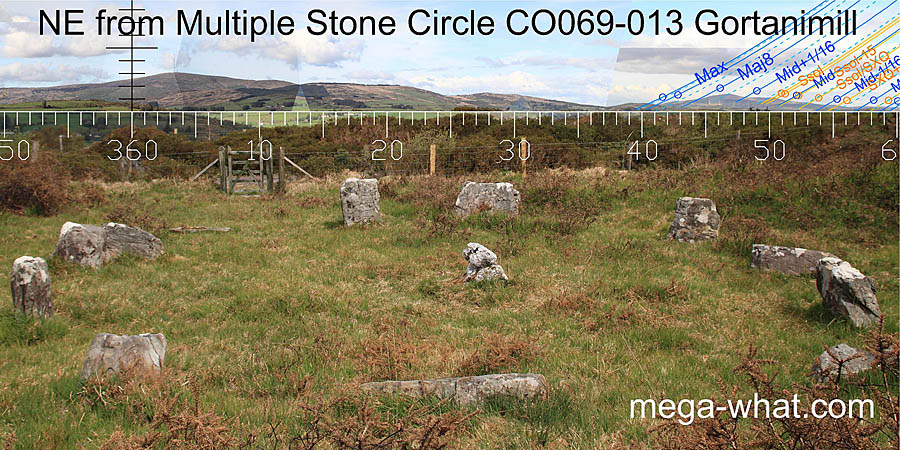 Gortanimill Stone Circle
Gortanimill Stone Circle:
The south-west horizon is very close and thus position sensitive but the circle axis clearly indicates major standstill. The axial reverse is well beyond the north-east lunar limit.
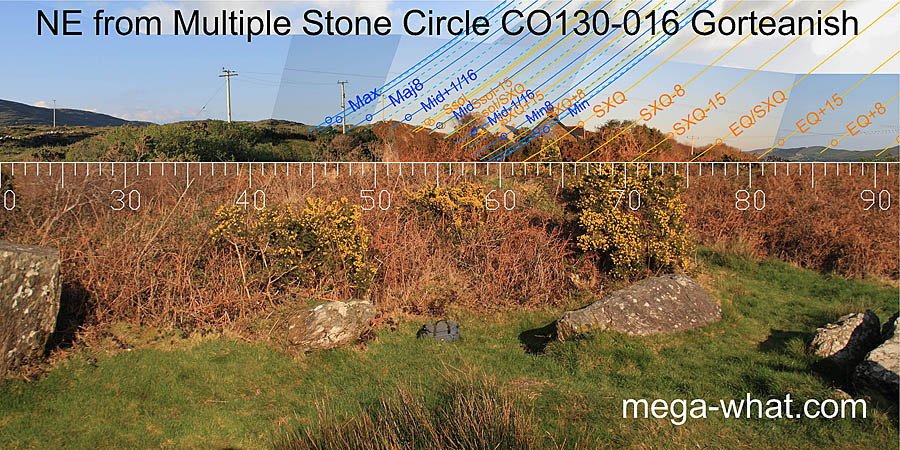
 Gorteanish Stone Circle
Gorteanish Stone Circle:
Both portals have fallen. The north one inwards, the south one outwards.
The north-east axis is thus somewhere in the summer solstice to solstice / cross-quarter midpoint region while the south-west axis would seem to have indicated the vicinity of winter cross-quarters.
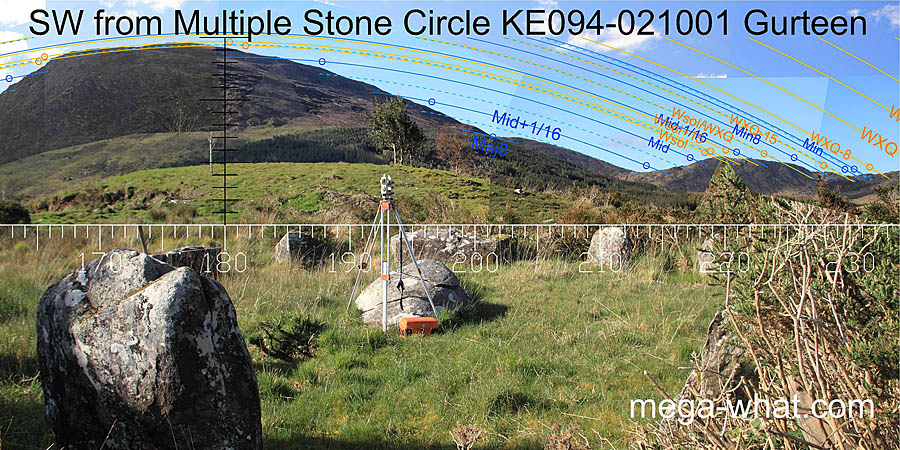
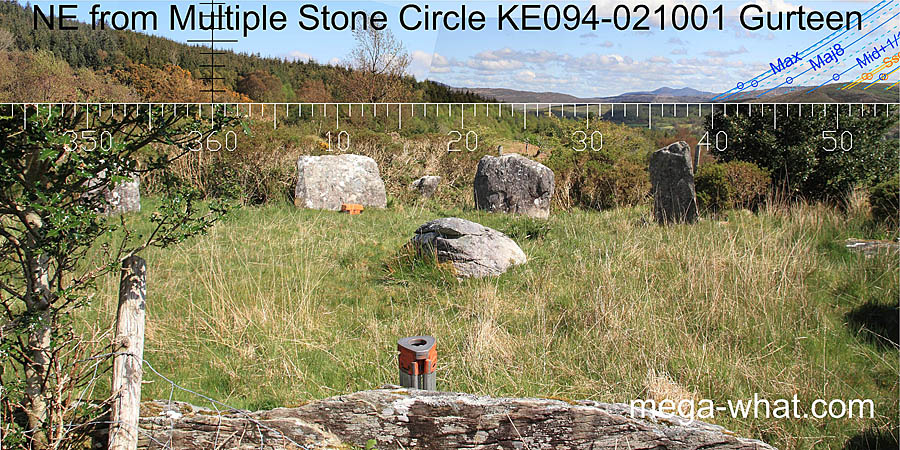 Gurteen Stone Circle
Gurteen Stone Circle:
To the south-west, the circle's axis indicates the lunar minor eighth, perhaps the sixteenth as well. The axial reverse is well beyond the north-east lunar limit.
The central boulder-burial's axis is slightly less extreme but the difference is not obviously significant.

 Illane Stone Circle
Illane Stone Circle:
The south-western axis is south of winter solstice and lunar mid-cycle but well within the lunistice range. The reverse is beyond major standstill.
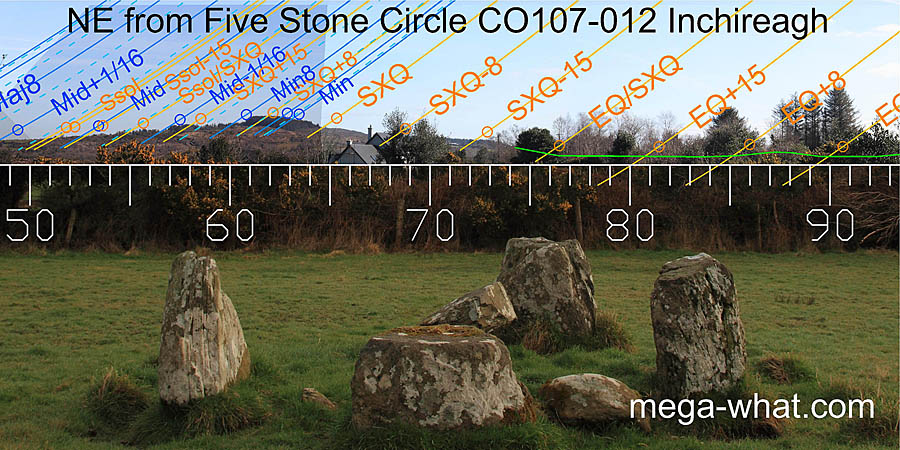
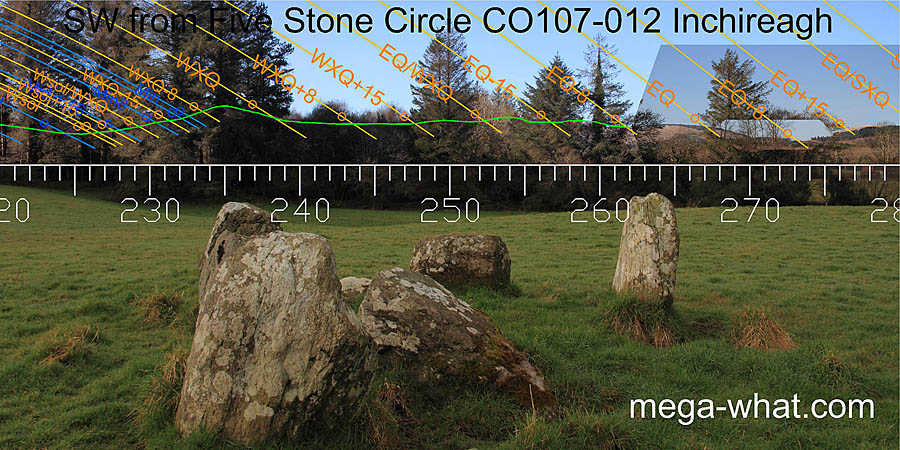 Inchireagh Stone Circle
Inchireagh Stone Circle:
The north portal has fallen but the south-western axis seems to be half-way between the equinox and the winter cross-quarters.
The north-eastern axis is a week or two south of the summer cross-quarters.

 Inchybegga Stone Circle
Inchybegga Stone Circle:
The axial stone is displaced but the north-eastern axis indicates summer solstice on a hilltop / lunar midpoint in a dip.
The south-west is obscured but the axis is towards the minor end of the lunistice range.
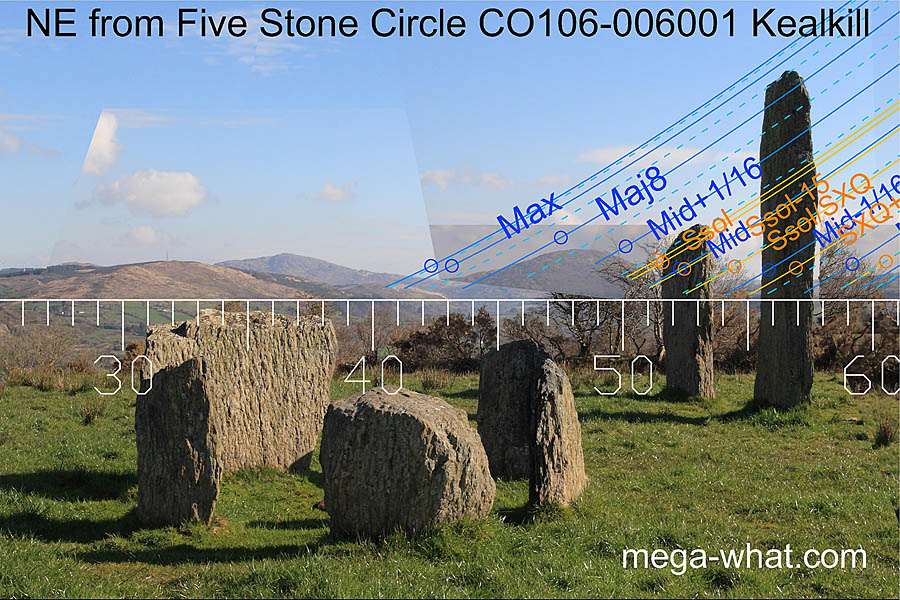
 Kealkill Stone Circle
Kealkill Stone Circle:
The circle axis indicates major standstill to the north-east and lunar major eighth to the south-west. The large portal is set east west and creates a north-south secondary axis.

 Knocknakilla Stone Circle
Knocknakilla Stone Circle:
The circle axis indicates major standstill to the south-west, the reverse is beyond it. It looks like the standing stone pair, which was probably there first, was the same.
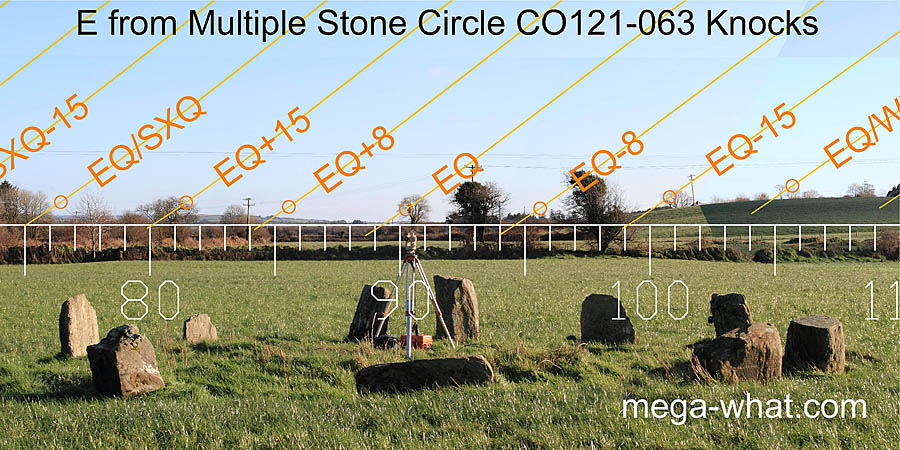
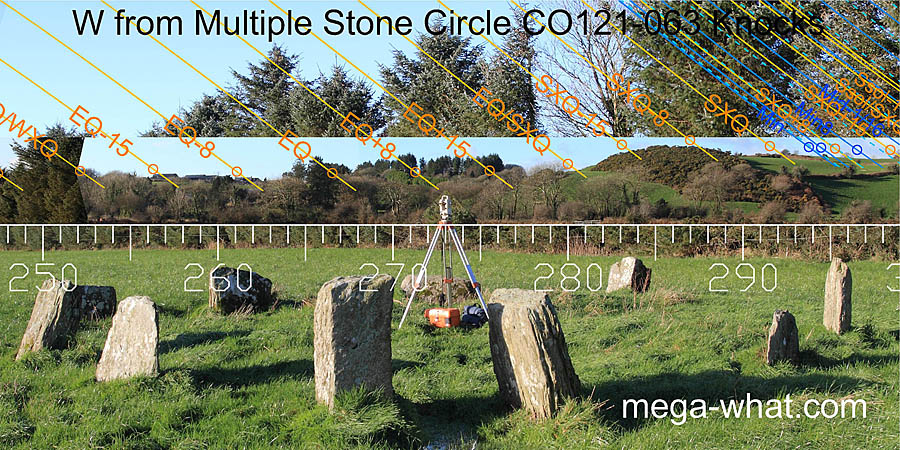 Knocks (N) Stone Circle
Knocks (N) Stone Circle:
Axial reverse clearly marks the equinox. To the west, the axis looks to be a quarter-month north of it. That is before the autumn equinox but after the spring one.

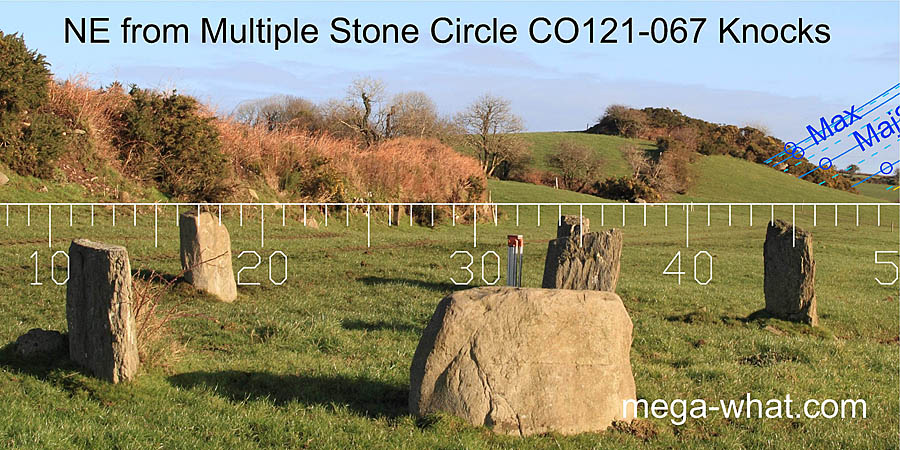 Knocks (S) Stone Circle
Knocks (S) Stone Circle:
The north portal is missing but the axis is towards the centre of the major half of the lunistice range. The reverse is well beyond major standstill.
The central monolith indicates major standstill to the south-east
[Pic].

 Lettergorman Stone Circle
Lettergorman Stone Circle:
The north portal is fallen. Axial reverse to the north-east indicates the major end of the lunistice range. The south-western axis points towards the centre of the major half of it.
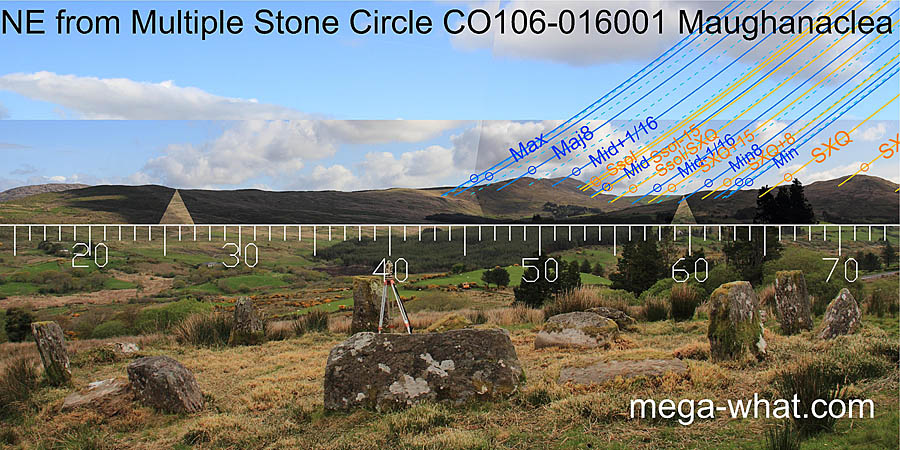
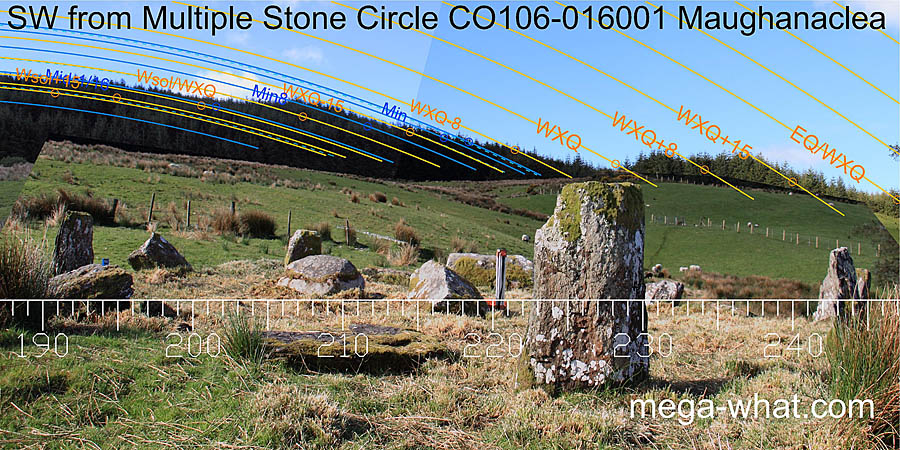 Maughanaclea Multiple Stone Circle
Maughanaclea Multiple Stone Circle:
One portal is fallen and there are two boulder-burials within. Axial reverse is just beyond major standstill but an upright portal there might mark it.
To the south-west, the axis indicates the minor end of the lunistice range but detail is obscured.

 Maughanaclea Five Stone Circle
Maughanaclea Five Stone Circle:
The south-western circle axis indicates the winter cross-quarters and the adjacent standing stone marks the solstice.
Axial reverse of the circle indicates the area of summer solstice sun rises. The stone marks major standstill
[Pic].
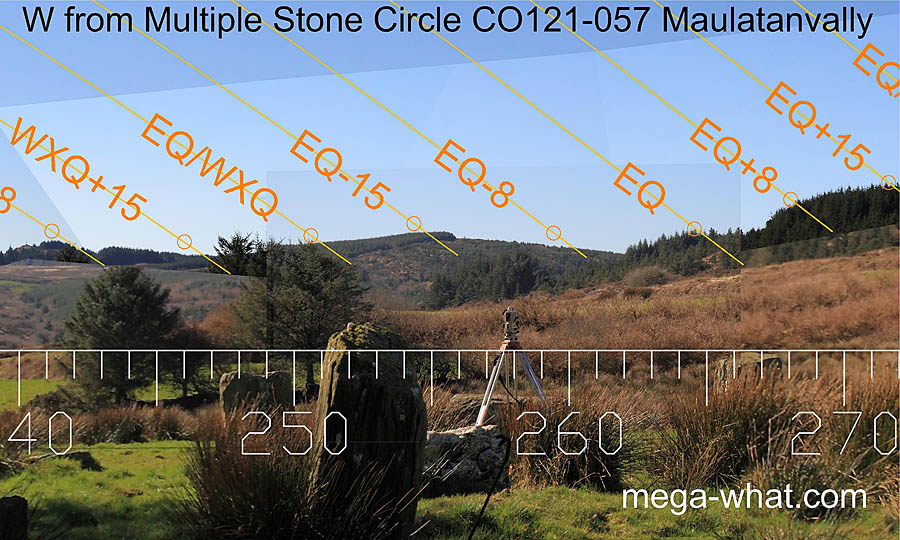
 Maulatanvally Stone Circle
Maulatanvally Stone Circle:
The north portal is missing and there is a quartzite block set within. The western axis is one to two weeks before spring equinox.
The eastern horizon is obscured but axial reverse might indicate the equinox / summer cross quarter midpoint.

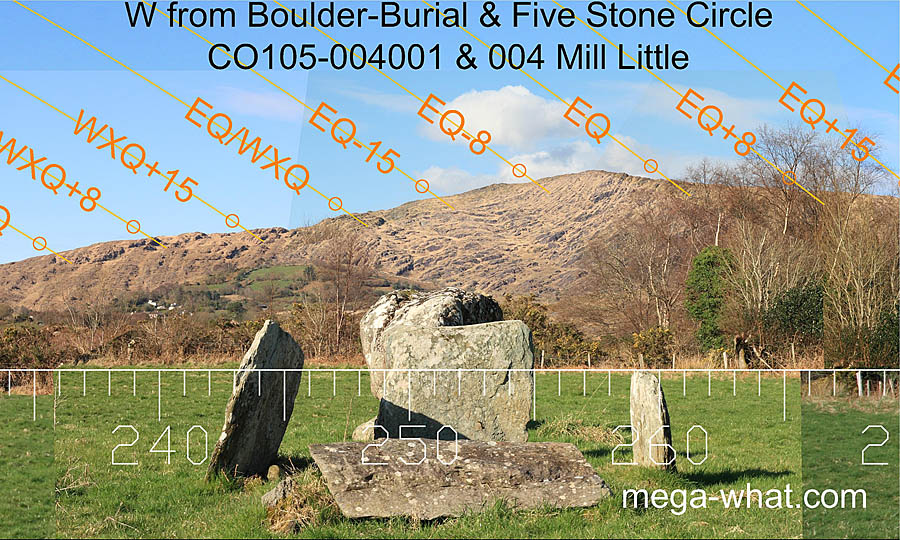 Mill Little N Boulder-Burial & Stone Circle
Mill Little N Boulder-Burial & Stone Circle:
Both boulder-burial and five stone circle indicate summer cross-quarters to the north-east. To the west they point a week or two south of the equinox (before the spring one).
The circle's radially set portals are both broken stumps and the slab across them is field clearance.
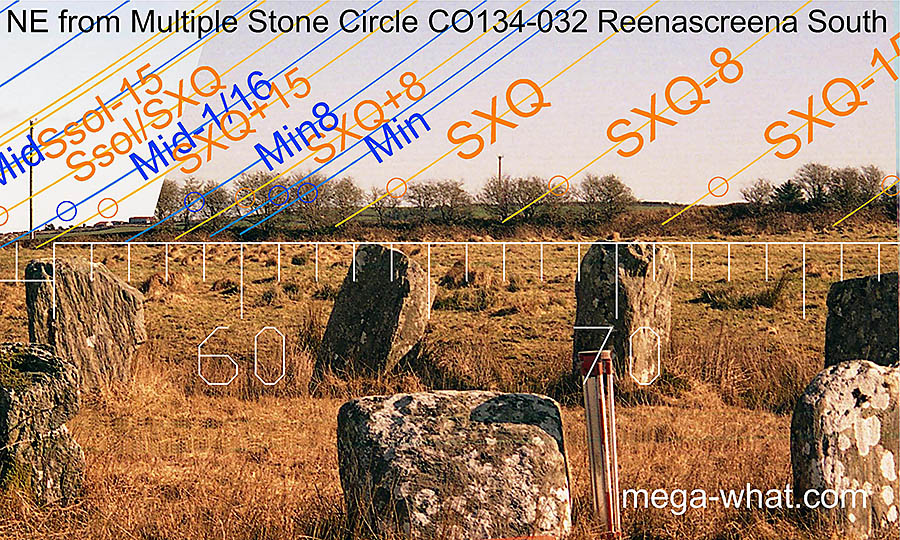
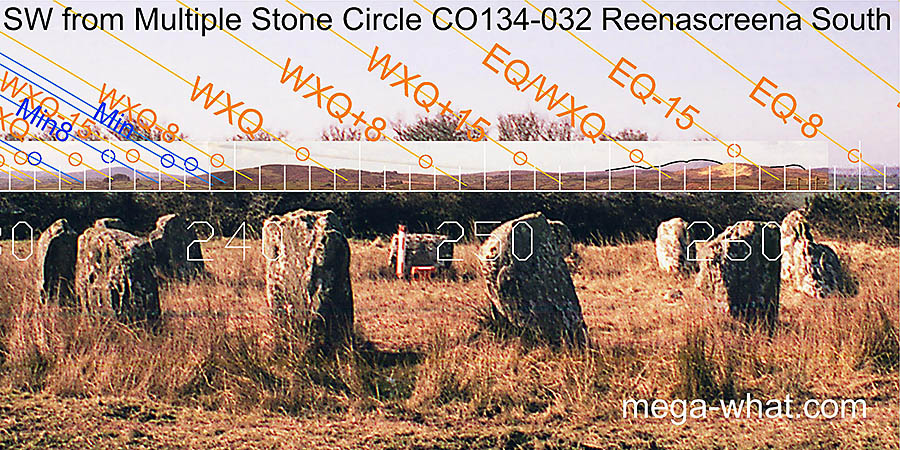 Reenascreena Stone Circle
Reenascreena Stone Circle:
The south-western axis is a week north of the winter cross-quarters and the north-eastern reverse is a week south of the summer cross-quarters.
That's before Lughnasadh and Samhain but after Imbolc and Bealtaine.

 Shronebirrane Stone Circle
Shronebirrane Stone Circle:
The north portal is missing. Due to the high local horizon, the south-western axis is half-way between equinox and summer cross-quarters. Axial reverse is towards the summer cross-quarters.
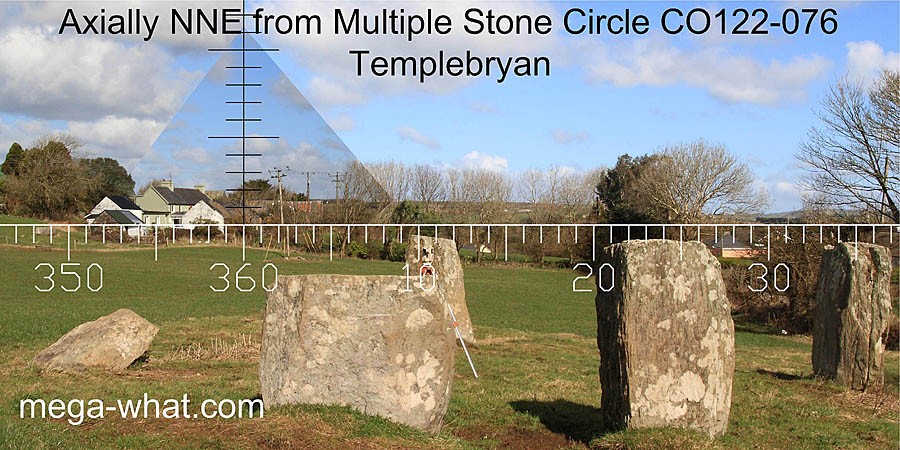
 Templebryan Stone Circle
Templebryan Stone Circle:
The presumed north portal is missing and there is a central monolith that indicates north-south exactly.
The circle's axial alignment is something less than 10° clockwise of that and it is not easy to understand why. Perhaps because the south-east horizon is better than the south-west one?
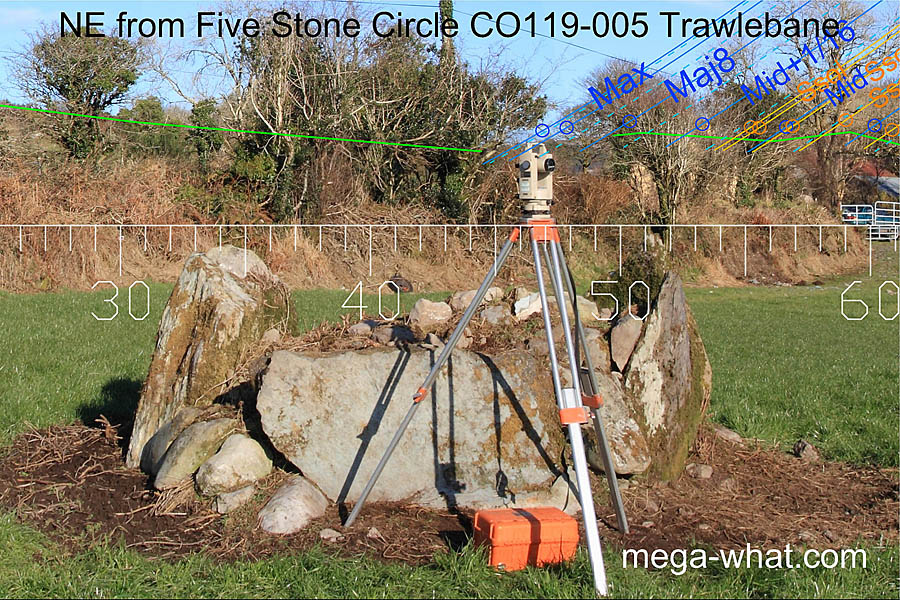
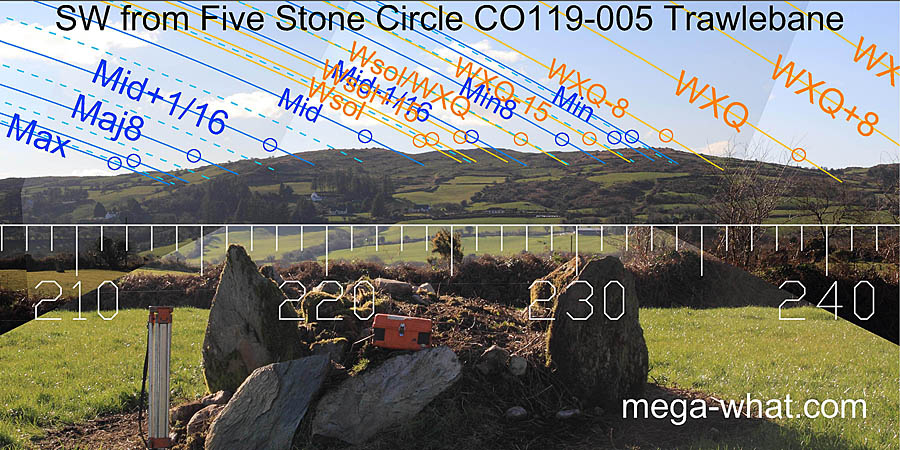 Trawlebane Stone Circle
Trawlebane Stone Circle:
The circle's south-western axis indicates lunar mid-cycle in a horizon notch. The north-eastern reverse might just include the major standstill.
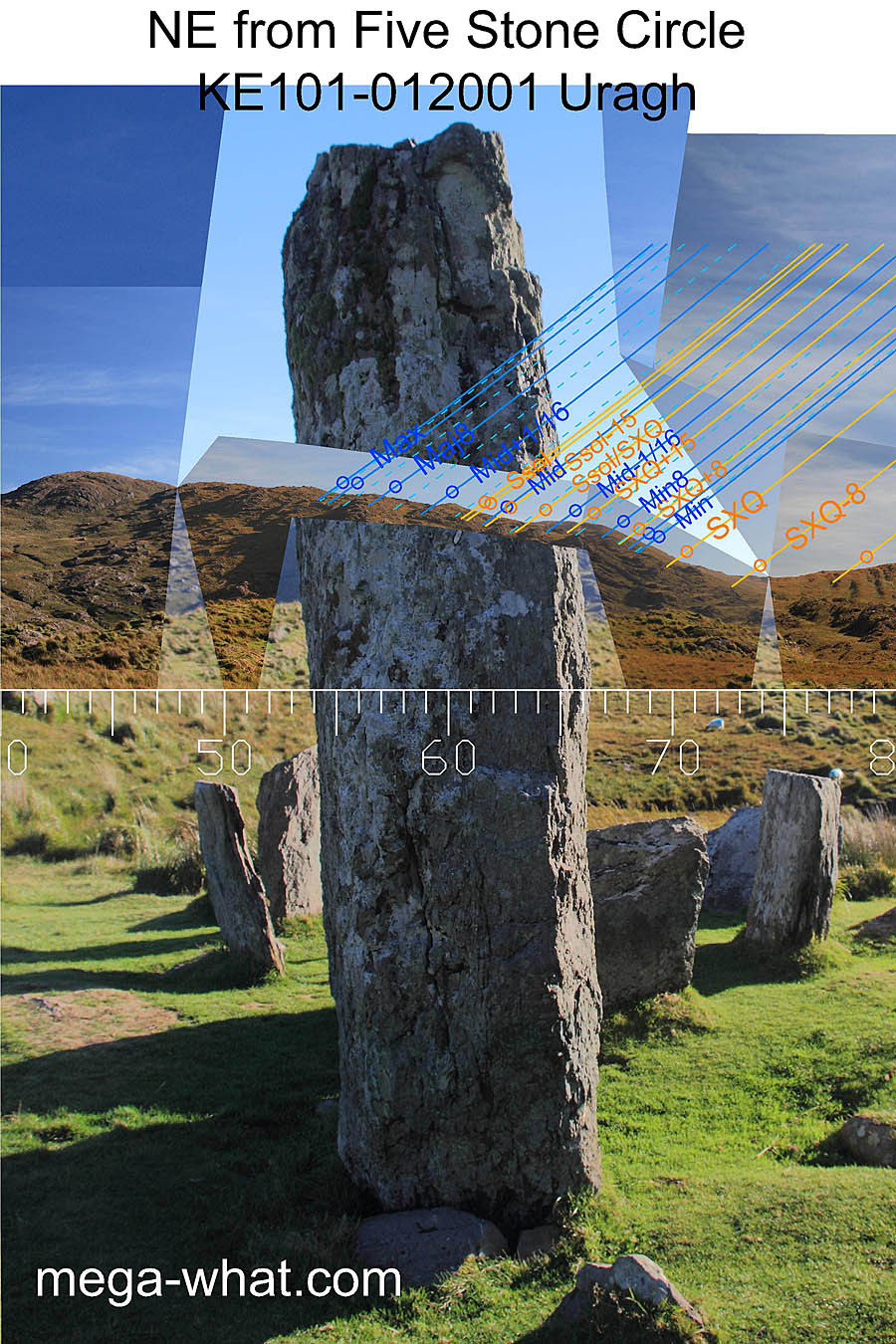
 Uragh Five Stone Circle
Uragh Five Stone Circle:
Axes are confused because of monument juxtaposition. To the north-east the standing stone may indicate summer solstice but the circle axis is somewhat further south.
To the south-west the axes are two or three weeks before spring equinox.
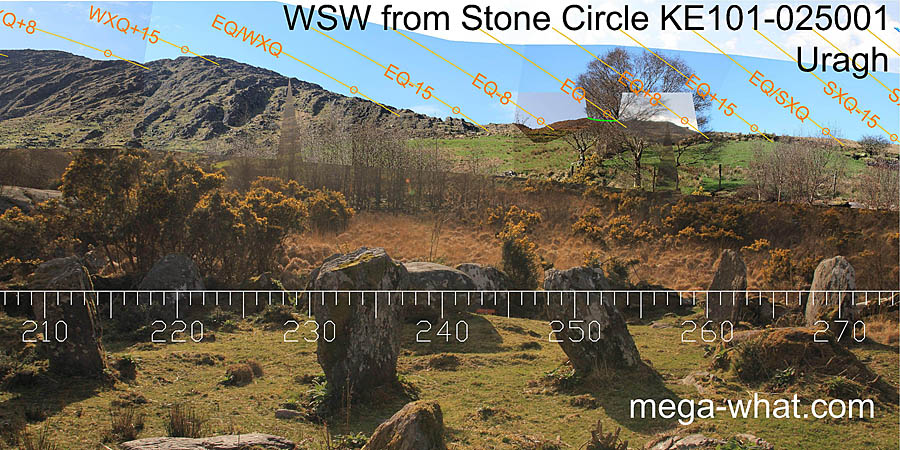
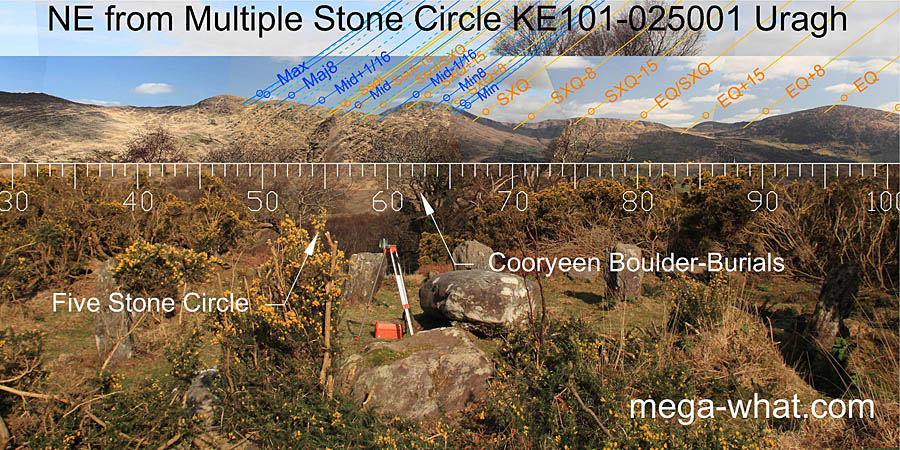 Uragh Multiple Stone Circle
Uragh Multiple Stone Circle:
The south-western axis of the circle is a half-month south of the equinox but the internal boulder-burial points to the half-month north of winter cross-quarters
[Pic].
The north-eastern axis of the circle is a half-month north of summer cross-quarters but the boulder-burial would be further north.
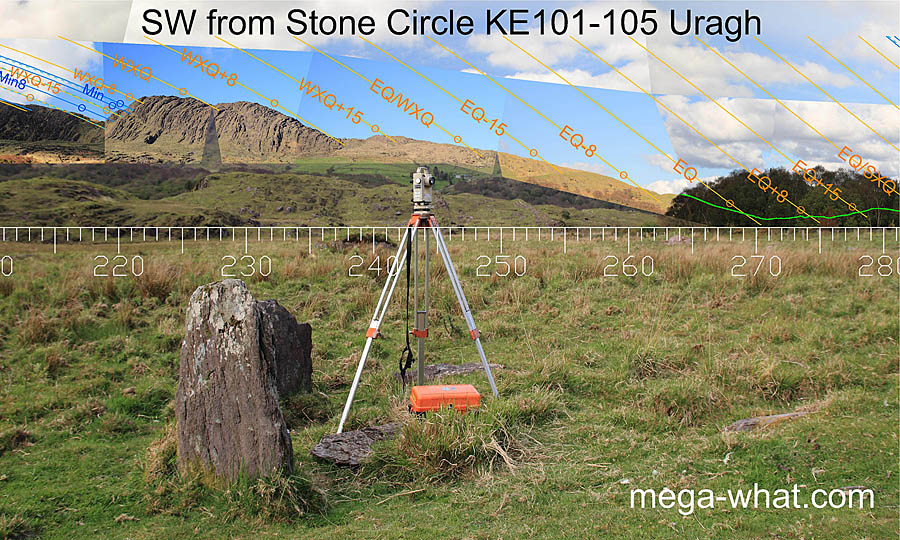
 Uragh Stone Circle
Uragh Stone Circle:
This five stone circle is badly damaged but the broken stump of the axial stone seems to be in situ.
The south-western axis indicates the equinox / winter cross-quarter midpoint. To the north-east, axial reverse is towards the major end of the lunistice range.
© Michael Wilson.



